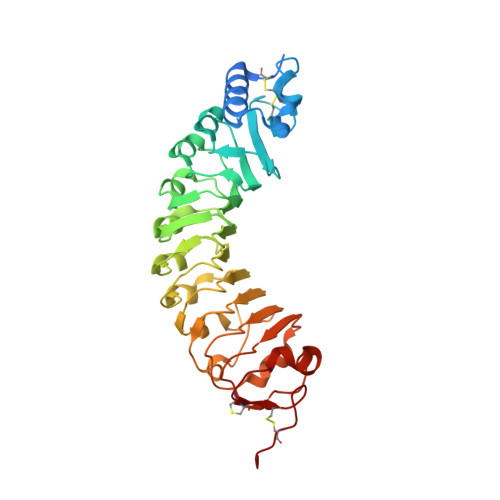Carrot 'antifreeze' protein has an irregular ice-binding site that confers weak freezing point depression but strong inhibition of ice recrystallization.
Wang, Y., Graham, L.A., Han, Z., Eves, R., Gruneberg, A.K., Campbell, R.L., Zhang, H., Davies, P.L.(2020) Biochem J 477: 2179-2192
- PubMed: 32459306
- DOI: https://doi.org/10.1042/BCJ20200238
- Primary Citation of Related Structures:
6W78 - PubMed Abstract:
Ice-binding proteins (IBPs) are found in many biological kingdoms where they protect organisms from freezing damage as antifreeze agents or inhibitors of ice recrystallization. Here, the crystal structure of recombinant IBP from carrot (Daucus carota) has been solved to a resolution of 2.3 Å. As predicted, the protein is a structural homologue of a plant polygalacturonase-inhibiting protein forming a curved solenoid structure with a leucine-rich repeat motif. Unexpectedly, close examination of its surface did not reveal any large regions of flat, regularly spaced hydrophobic residues that characterize the ice-binding sites (IBSs) of potent antifreeze proteins from freeze-resistant fish and insects. An IBS was defined by site-directed mutagenesis of residues on the convex surface of the carrot solenoid. This imperfect site is reminiscent of the irregular IBS of grass 'antifreeze' protein. Like the grass protein, the carrot IBP has weak freezing point depression activity but is extremely active at nanomolar concentrations in inhibiting ice recrystallization. Ice crystals formed in the presence of both plant proteins grow slowly and evenly in all directions. We suggest that this slow, controlled ice growth is desirable for freeze tolerance. The fact that two plant IBPs have evolved very different protein structures to affect ice in a similar manner suggests this pattern of weak freezing point depression and strong ice recrystallization inhibition helps their host to tolerate freezing rather than to resist it.
Organizational Affiliation:
Shanghai Institute for Advanced Immunochemical Studies (SIAIS), ShanghaiTech University, Shanghai 201210, China.















